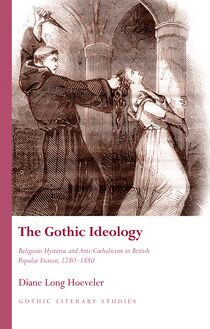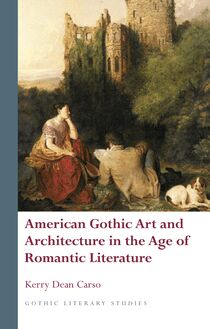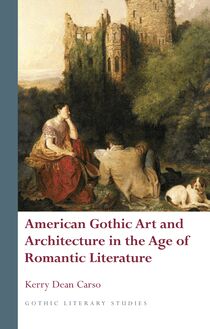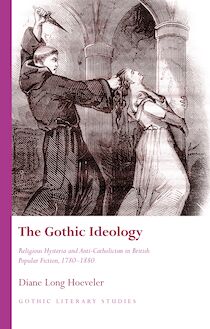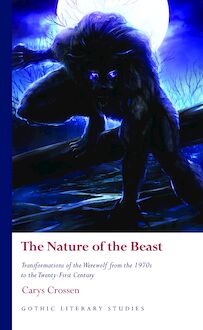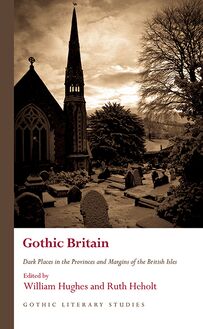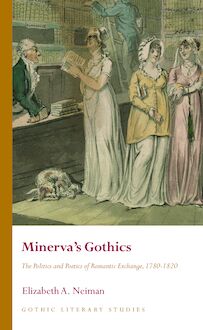-
 Univers
Univers
-
 Ebooks
Ebooks
-
 Livres audio
Livres audio
-
 Presse
Presse
-
 Podcasts
Podcasts
-
 BD
BD
-
 Documents
Documents
-
- Cours
- Révisions
- Ressources pédagogiques
- Sciences de l’éducation
- Manuels scolaires
- Langues
- Travaux de classe
- Annales de BEP
- Etudes supérieures
- Maternelle et primaire
- Fiches de lecture
- Orientation scolaire
- Méthodologie
- Corrigés de devoir
- Annales d’examens et concours
- Annales du bac
- Annales du brevet
- Rapports de stage
La lecture à portée de main
214 pages
English
Découvre YouScribe en t'inscrivant gratuitement
Je m'inscrisHistory of the Gothic: Twentieth-Century Gothic , livre ebook
Découvre YouScribe en t'inscrivant gratuitement
Je m'inscris
Obtenez un accès à la bibliothèque pour le consulter en ligne
En savoir plus
En savoir plus
214 pages
English
Obtenez un accès à la bibliothèque pour le consulter en ligne
En savoir plus
En savoir plus

Description
Why, at a time when the majority of us no longer believe in ghosts, demons or the occult, does Gothic continue to have such a strong grasp upon literature, cinema and popular culture? This book answers the question by exploring some of the ways in which we have applied Gothic tropes to our everyday fears. The book opens with The Turn of the Screw, a text dealing in the dangers adults pose to children whilst simultaneously questioning the assumed innocence of all children. Staying with the domestic arena, it explores the various manifestations undertaken by the haunted house during the twentieth century, from the bombed-out spaces of the blitz ('The Demon Lover' and The Night Watch) to the designer bathrooms of wealthy American suburbia (What Lies Beneath). The monsters that emerge through the uncanny surfaces of the Gothic can also be terror monsters, and after a discussion of terrorism and atrocity in relation to burial alive, the book examines the relationship between the human and the inhuman through the role of the beast monster as manifestation of the evil that resides in our midst (The Hound of the Baskervilles and The Birds). It is with the dangers of the body that the Gothic has been most closely associated and, during the later twentieth century, paranoia attaches itself to skeletal forms and ghosts in the wake of the HIV/AIDS crisis. Sexuality and/as disease is one of the themes of Patrick McGrath's work (Dr Haggard's Disease and 'The Angel') and the issue of skeletons in the closet is also explored through Henry James's 'The Jolly Corner'. However, sexuality is also one of the most liberating aspects of Gothic narratives. After a brief discussion of camp humour in British television drama series Jekyll, the book concludes with a discussion of the apparitional lesbian through the work of Sarah Waters.
Introduction The Gothic Attraction and/of the Counterfeit Gothic Culture and the Marketplace Chapter One - Gothic Pathologies: Haunted Children Child Murder and the Media Storm Fairy Stories and 'Burial Alive': A.S. Byatt and Graham Joyce Photographing Fairies: Framing the Dead Death and the Dolls' House: FairyTale: A True Story and M.R. James Chapter Two - Building Suspense: Architectural Gothic Haunted Geometries I: Kipling, 'Swept and Garnished' Haunted Geometries II: Eco, The Name of the Rose Suburban and Rural Monstrosity: Clive Barker and Iain Banks London Gothic: Elizabeth Bowen and Sarah Waters Designer Bathtubs and Drowning in Air: What Lies Beneath Chapter Three - Gothic Inhumanity Bestiality and the Gothic: Sir Arthur Conan Doyle and Leonora Carrington Vampires and Bloodfests: Leonora Carrington and Clive Barker Monster Birds - Du Maurier and Hitchcock 'Daddy's Home!': Jekyll Chapter Four - Queering the Gothic Jolly Queer - Henry James The Apparitional Lesbian: Sarah Waters AIDS/HIV and the Gothicising of Male Homosexuality: Patrick McGrath Chapter Five - Survey of Criticism Chapter Six - Conclusion: Thriller and Stranger
Introduction The Gothic Attraction and/of the Counterfeit Gothic Culture and the Marketplace Chapter One - Gothic Pathologies: Haunted Children Child Murder and the Media Storm Fairy Stories and 'Burial Alive': A.S. Byatt and Graham Joyce Photographing Fairies: Framing the Dead Death and the Dolls' House: FairyTale: A True Story and M.R. James Chapter Two - Building Suspense: Architectural Gothic Haunted Geometries I: Kipling, 'Swept and Garnished' Haunted Geometries II: Eco, The Name of the Rose Suburban and Rural Monstrosity: Clive Barker and Iain Banks London Gothic: Elizabeth Bowen and Sarah Waters Designer Bathtubs and Drowning in Air: What Lies Beneath Chapter Three - Gothic Inhumanity Bestiality and the Gothic: Sir Arthur Conan Doyle and Leonora Carrington Vampires and Bloodfests: Leonora Carrington and Clive Barker Monster Birds - Du Maurier and Hitchcock 'Daddy's Home!': Jekyll Chapter Four - Queering the Gothic Jolly Queer - Henry James The Apparitional Lesbian: Sarah Waters AIDS/HIV and the Gothicising of Male Homosexuality: Patrick McGrath Chapter Five - Survey of Criticism Chapter Six - Conclusion: Thriller and Stranger
Sujets
Informations
| Publié par | University of Wales Press |
| Date de parution | 15 janvier 2011 |
| Nombre de lectures | 1 |
| EAN13 | 9780708323625 |
| Langue | English |
| Poids de l'ouvrage | 1 Mo |
Informations légales : prix de location à la page 0,0650€. Cette information est donnée uniquement à titre indicatif conformément à la législation en vigueur.
Extrait
History of the Gothic: Twentieth-Century Gothic
Lucie Armitt
University of Wales Press
TWENTIETH-CENTURY GOTHIC
SERIESPREFACE
Gothic Literary Studies is dedicated to publishing groundbreaking scholarship on Gothic in literature and film.The Gothic, which has been subjected to a variety of critical and theoretical approaches, is a form which plays an important role in our understanding of literary, intellectual and cultural histories.The series seeks to promote challenging and innovative approaches to Gothic which question any aspect of the Gothic tradition or perceived critical orthodoxy. Volumes in the series explore how issues such as gender, religion, nation and sexuality have shaped our view of the Gothic tradition. Both academically rigorous and informed by the latest developments in critical theory, the series provides an important focus for scholastic developments in Gothic studies, literary studies, cultural studies and critical theory.The series will be of interest to students of all levels and to scholars and teachers of the Gothic and literary and cultural histories.
SERIESEDITORS
Andrew Smith, University of Glamorgan Benjamin F. Fisher, University of Mississippi
EDITORIALBOARD
Kent Ljungquist,Worcester Polytechnic Institute Massachusetts Richard Fusco, St Joseph’s University, Philadelphia David Punter, University of Bristol Chris Baldick, University of London Angela Wright, University of Sheffield Jerrold E. Hogle, University of Arizona
HISTORY OF THE GOTHIC
Twentieth-Century Gothic
Lucie Armitt
UNIVERSITY OF WALES PRESS C A R D I F F 2 0 1 1
© Lucie Armitt, 2011
All rights reserved. No part of this book may be reproduced in any material form (including photocopying or storing it in any medium by electronic means and whether or not transiently or incidentally to some other use of this publication) without the written permission of the copy-right owner.Applications for the copyright owner’s written permission to reproduce any part of this publication should be addressed to the University of Wales Press, 10 Columbus Walk, Brigantine Place, Cardiff, CF10 4UP.
www.uwp.co.uk
British Library CIP Data A catalogue record for this book is available from the British Library.
ISBN 978-0-7083-2007-5 (hardback) 978-0-7083-2043-3 (paperback) e-ISBN 978-0-7083-2362-5
The right of Lucie Armitt to be identified as author of this work has been asserted in accordance with sections 77 and 79 of the Copyright, Designs and Patents Act 1988.
Typeset by Eira Fenn Gaunt at the University of Wales Press Printed by CPI Antony Rowe, Chippenham,Wiltshire
Series Editors’ Foreword
Acknowledgements
Chronology
Illustrations
Introduction
1
2
3
4
5
6
CONTENTS
Gothic Pathologies: Haunted Children
Building Suspense: Architectural Gothic
Gothic Inhumanity
Queering the Gothic
Survey of Criticism
Conclusion:ThrillerandStranger
Notes
Annotated Bibliography
Index
vii
ix
xii
xvii
1
15
48
81
116
144
160
167
178
187
SERIESEDITORS’ FOREWORD
The History of the Gothic series consists of four volumes:Gothic Literature 1764–1824,Gothic Literature 1825–1914,Twentieth-Century GothicandAmerican Gothic.The series provides a comprehensive intro-duction to the history of Gothic Literature and to a variety of critical and theoretical approaches.Volumes in the series also raise questions about how the Gothic canon has been received and seek to critically challenge, rather than simply reaffirm, commonplace perceptions of the Gothic tradition. Whilst intended as an introduction to the history of the Gothic they thus also provide a rigorous analysis of how that history has been developed and suggest ways in which it can be critically renegotiated. The series will be of interest to students of all levels who are new to the Gothic and to scholars and teachers of the history of Gothic Literature.The series will also be of interest to students and scholars working more broadly within the areas of literary studies, cultural studies, and critical theory.
Andrew Smith,University of Glamorgan Benjamin F. Fisher,University of Mississippi
-
 Univers
Univers
-
 Ebooks
Ebooks
-
 Livres audio
Livres audio
-
 Presse
Presse
-
 Podcasts
Podcasts
-
 BD
BD
-
 Documents
Documents
-
Jeunesse
-
Littérature
-
Ressources professionnelles
-
Santé et bien-être
-
Savoirs
-
Education
-
Loisirs et hobbies
-
Art, musique et cinéma
-
Actualité et débat de société
-
Jeunesse
-
Littérature
-
Ressources professionnelles
-
Santé et bien-être
-
Savoirs
-
Education
-
Loisirs et hobbies
-
Art, musique et cinéma
-
Actualité et débat de société
-
Actualités
-
Lifestyle
-
Presse jeunesse
-
Presse professionnelle
-
Pratique
-
Presse sportive
-
Presse internationale
-
Culture & Médias
-
Action et Aventures
-
Science-fiction et Fantasy
-
Société
-
Jeunesse
-
Littérature
-
Ressources professionnelles
-
Santé et bien-être
-
Savoirs
-
Education
-
Loisirs et hobbies
-
Art, musique et cinéma
-
Actualité et débat de société
- Cours
- Révisions
- Ressources pédagogiques
- Sciences de l’éducation
- Manuels scolaires
- Langues
- Travaux de classe
- Annales de BEP
- Etudes supérieures
- Maternelle et primaire
- Fiches de lecture
- Orientation scolaire
- Méthodologie
- Corrigés de devoir
- Annales d’examens et concours
- Annales du bac
- Annales du brevet
- Rapports de stage
Signaler un problème
YouScribe
Le catalogue
Le service
© 2010-2024 YouScribe

